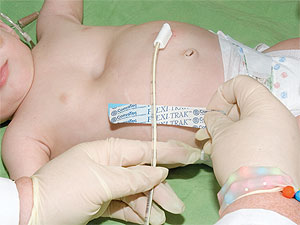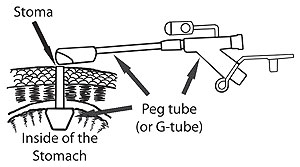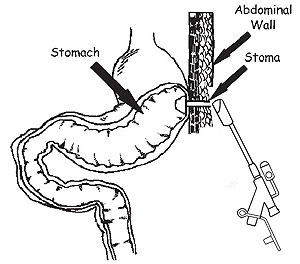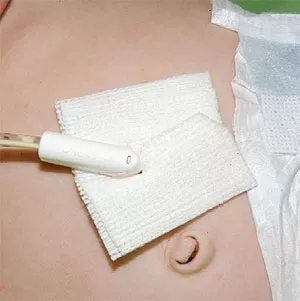

A Percutaneous Endoscopic Gastrostomy tube (PEG) is a soft plastic feeding tube placed into the stomach. The PEG tube will come out of a small surgical opening in the abdomen called a stoma.
A PEG tube might be useful if a child cannot eat or drink well. The tube makes it possible to give your child liquid food, formula, and fluids as well as some types of medicines. Having a PEG tube does not mean your child can’t eat or drink by mouth. A feeding tube may be used for a short period of time or for many years. The PEG tube is replaced with a low-profile gastrostomy button (G-button) in three months after the stomach has healed.
What to expect on the day of your procedure
- You will stay in the hospital at least overnight after the PEG placement.
- Report to the Pediatric Specialty Clinic or the operating room (OR) area as instructed.
- The GI or anesthesia office will call with instructions before your procedure day. Your child will have restrictions they must follow on what they can and cannot eat and drink before the procedure.
- A gastroenterologist will see you before the procedure begins.
- You can stay with your child until the procedure begins. You will then be directed back to the waiting area. The procedure usually takes 30 to 60 minutes.
- Medicine will be given through an intravenous (IV) line so that your child will sleep during the procedure. An antibiotic will also be given.
- The IV may be used for pain medication during your stay. It is removed before you go home.
- After the procedure, you will remain in the recovery area until your child is awake. You will then go to a hospital room
to meet the doctors and nurses who will care for you.
How is a PEG tube placed?

Your child is given medication to go to sleep during the procedure. An endoscope is a flexible tube with a camera and light at the end. It goes into the mouth and down into the stomach to find a spot for the tube. The skin is cleaned and the area numbed with medicine. A special needle is put through the skin into the stomach. We then use wires and/or other devices to put the tube in. The hole that is made into the stomach is called a stoma.
The kinds of tubes we place will be discussed by your doctor.
They are most often the one you see in the picture.
Possible complications:
About 10% to 15% of patients will have at least one complication
- Medication reaction
- Infection (about 10%)
- Fever (uncommon)
- Bleeding (uncommon)
- A hole in the wall of the esophagus, stomach, or colon (about 1%)
- Procedure is cancelled if a safe place to put the PEG tube cannot be found (< 5%)
What to expect one to two days after PEG placement

- Pain around the PEG site is common for a few days. In the hospital, it is usually treated with acetaminophen (Tylenol). Sometimes an IV medication is needed (like Morphine). Tylenol is usually all that is necessary at home (by mouth or through the tube).
- The skin right around the PEG-tube may look pink or light red. You may see some pink drainage around the tube that turns green over time. This is normal.
- It is best to keep the area around the tube clean, dry, and open to the air. If you want to cover the area, use an absorbent gauze pad or feminine hygiene pad. Cut it into a small square (see figure). Cut a “ t” shape into the pad so it fits around the tube. If using a feminine hygiene pad, place the absorbent side on the skin so it soaks up moisture. Do not stick the pad to the skin.
- Formula feedings will be started and increased until the feeding goal is reached.
- You should stay in the hospital with your child to learn how the tube is used. A GI nurse will come by to show you how to care for the tube and use the feeding equipment.
- You can take a bath three days after the PEG placement. Do not swim or let the skin where the tube went in go under water for at least two weeks, until the site is healed.
- The PEG tube may turn or rotate. This will not hurt your child or break the tube.
Last modified 12/1/10